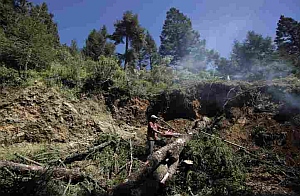Mexico City - Illegal logging more than tripled in the monarch butterfly's wintering grounds in central Mexico, reversing several years of steady improvements, investigators announced Tuesday.
 |
That's the highest figure since 2009, well above the 20 acres (8 hectares) lost in 2014, according to the announcement by the World Wildlife Fund and the Institute of Biology of Mexico's National Autonomous University. The 2014 loss was about 12 acres (5 hectares) due to logging and 8 acres (3 hectares) to drought.
Illegal logging fell to almost zero in 2012, and experts stressed that 31 of the 32 communities in the reserve had kept logging down to very, very low levels.
The forest canopy is a sort of blanket against cold for the masses of orange-and-black butterflies that form huge clumps on tree branches during their winter stay in Mexico.
 |
This year butterflies that reached the wintering grounds covered 2.79 acres (1.13 hectares), a 69 percent rebound from last February's 1.65 acres (0.67 hectare), which was the lowest since record-keeping began in 1993. Butterflies cluster so closely together that they are counted by the area they cover, rather than by the number of individuals.
At their peak in 1996, the monarchs covered more than 44.5 acres (18 hectares) in the mountains west of Mexico City. But the overall tendency since then has been a steep, progressive decline. Each time the Monarchs rebound, they do so at lower levels. The species is found in many countries and is not in danger of extinction, but experts fear the migration could be disrupted if very few butterflies make the 3,400-mile (5,470-km) trip.
Largely Indian farm communities in the mountain reserve have received government development funds in return for preserving the 139,000-acre (56,259 hectare) reserve in the mountains west of Mexico City that UNESCO has declared a World Heritage site. Some of the communities earn income from tourist operations or reforestation nurseries to grow and plant saplings. Funding for the hamlet of San Felipe de los Alzati has temporarily been suspended due to the logging there.
 |
"The government has to step up enforcement and start talking more seriously with this community, to find out the causes" behind the logging, Vidal said. Some communities have complained that outside loggers - sometimes armed - invade local forests without the consent of the community. Other logging, however, has been the work of locals who have few other job opportunities."
After illegal logging felled hundreds of acres of trees in the reserve between 2003 and 2006, authorities cracked down on illegal sawmills and stepped up incentives to encourage communities to preserve the woods.
"The main problem in Mexico is the lack of protection," said writer and activist Homero Aridjis, who noted that some officials at the reserve were replaced and that President Enrique Peņa Nieto recently appointed his cousin, Alejandro del Mazo, to head the agency that oversees Mexico's nature reserves.
Del Mazo's office did not immediately respond to requests for comment.
Source: abcnews.go.com


